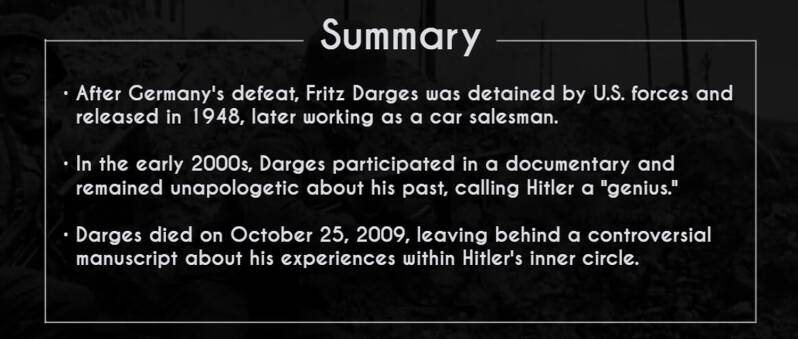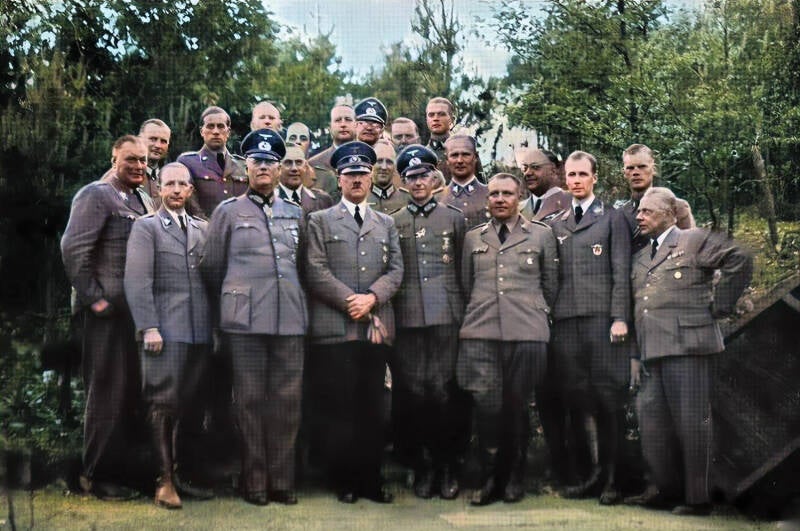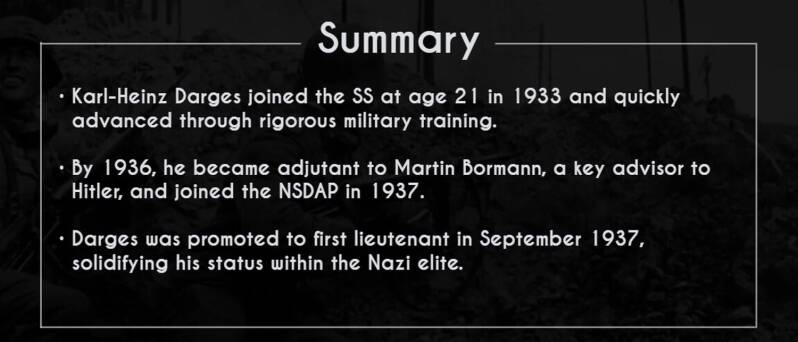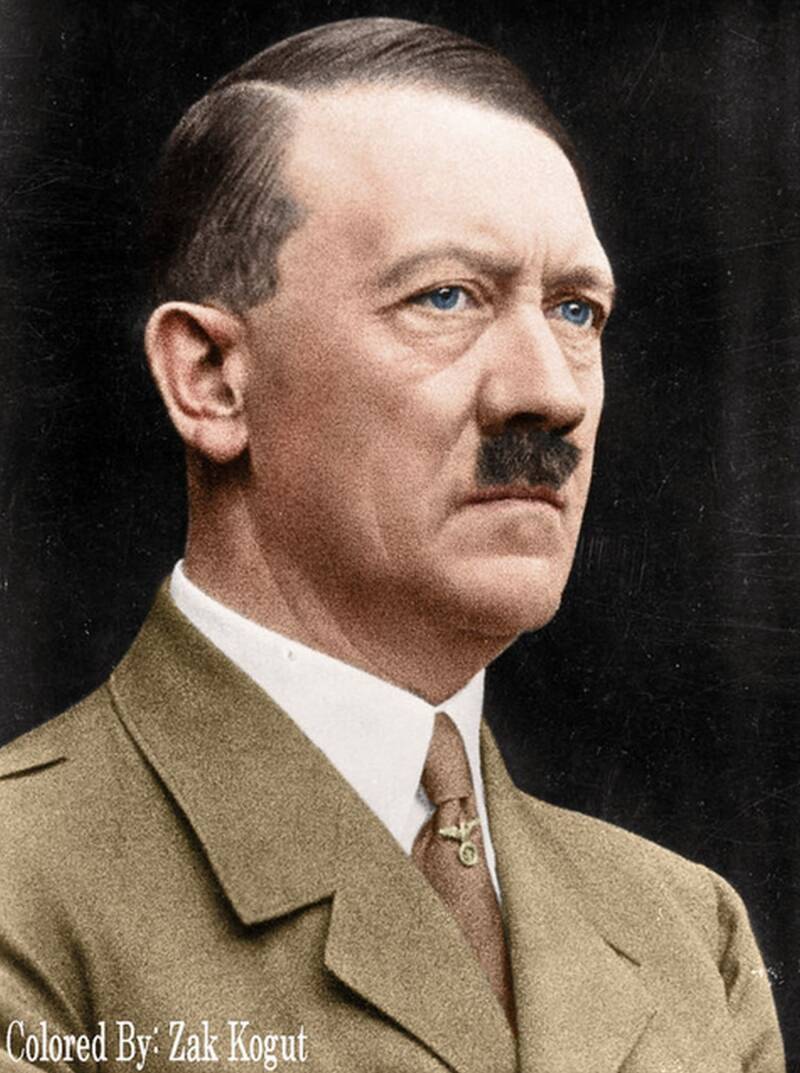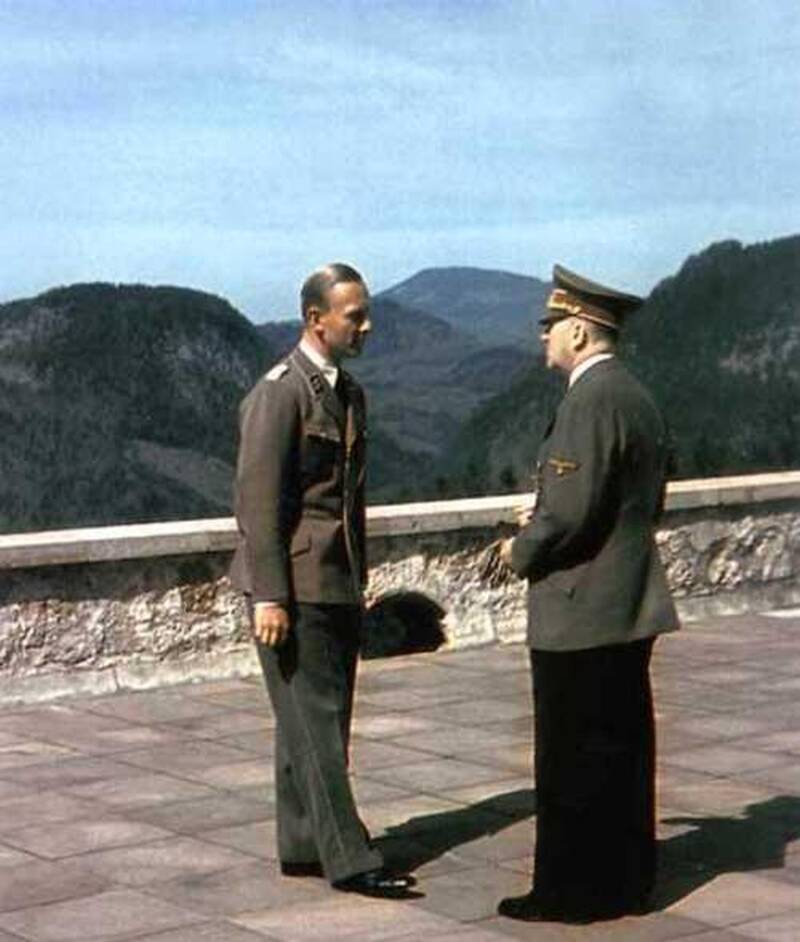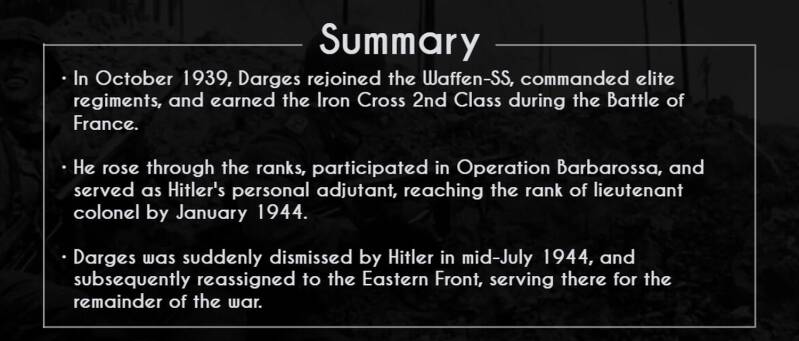A Fly, a Snicker, and Hitler's Wrath
From SS Officer to Hitler's Personal Adjutant to the Eastern Front
Karl-Heinz Darges was a figure who epitomized the ambition and loyalty of the Nazi regime’s inner circle, navigating the complex and perilous world of Hitler’s top officers.
Born in the small village of Dülseberg near Salzwedel, Germany, Darges quickly aligned himself with the rising Nazi movement as a young man.
His early dedication to the Schutzstaffel (SS) saw him rise rapidly through its ranks, securing influential positions and ultimately becoming one of Adolf Hitler’s personal adjutants.
Throughout his military career, he was involved in critical campaigns on the Eastern Front during the Second World War, commanding elite armored units in some of the war’s fiercest battles.
However, despite his closeness to Hitler, his career came to an abrupt end in 1944 following a seemingly innocuous joke during a strategy meeting, which led to his swift dismissal by the Führer himself.
Adolf Hitler and entourage in May 1940. As one of Hitler’s personal adjutants, Karl-Heinz Darges was deeply embedded in the Führer’s inner circle, attending high-level military briefings and strategy sessions. His proximity to Hitler granted him significant influence, but it also exposed him to the leader’s unpredictable temper.
https://www.npr.org/sections/thetwo-way/2009/10/hitler_aides_death_could_shed.html
Henry Guttmann/Hulton Archive/Getty Images
Early Life
Karl-Heinz Darges was born in the small village of Dülseberg near Salzwedel, Germany, in the early 20th century. After completing his schooling,
Darges aligned himself with the rising Nazi regime by volunteering for the Schutzstaffel (SS) in April 1933, at the age of just 21. His ambition and dedication quickly drew the attention of his superiors, leading him to the prestigious SS-Junkerschule in Bad Tölz, where he underwent rigorous military training.
Upon graduating in April 1935, Darges earned the rank of Untersturmführer (second lieutenant), setting the stage for his rapid ascent within the Nazi hierarchy.
By 1936, Darges’ talents had secured him a highly coveted position as adjutant to **Martin Bormann**, one of Hitler’s closest and most influential advisors. In May 1937, he officially joined the National Socialist German Workers' Party (NSDAP).
Just a few months later, in September, he was promoted to Obersturmführer (first lieutenant), further solidifying his status within the party’s elite circles.
Rise in the SS
When the winds of war swept across Europe, Darges was drawn back into active military service.
In October 1939, he rejoined the Waffen-SS, taking command of a company within the elite "Deutschland" and "Der Führer" Regiments, which were part of the SS-Verfügungstruppe (SS-VT).
During the Battle of France, his leadership on the battlefield earned him the **Iron Cross 2nd Class** in July 1940, followed by a promotion to Hauptsturmführer (captain).
...he received the Iron Cross...
Darges' career continued to climb as he was assigned to the newly-formed SS Division Wiking, one of the most formidable units on the Eastern Front.
He participated in Operation Barbarossa, the massive invasion of the Soviet Union, which would become a brutal and protracted conflict.
For his actions, he received the Iron Cross 1st Class in August 1942, marking him as one of the SS’s most capable officers.
A group of German infantrymen advancing along a dirt path while their commanding officer pauses to salute a General who is reviewing the men during the early stages of Operation Barbarossa, the Axis invasion of the Soviet Union, Summer, 1941.
...Darges' career took an unexpected turn...
In March 1943, Darges was selected for a highly sensitive role as one of Hitler's personal adjutants.
This prestigious assignment placed him within the Führerbegleitkommando, a specialized SS unit responsible for Hitler's personal security.
He became a constant presence in Hitler’s inner circle during critical military briefings and strategy meetings, rising to the rank of Obersturmbannführer (lieutenant colonel) by January 1944.
Darges’ proximity to Hitler brought both honor and peril. In mid-July 1944, just days before the infamous 20 July Plot to assassinate Hitler, Darges' career took an unexpected turn during a tense strategy meeting at Hitler's Wolfsschanze (Wolf's Lair) headquarters in East Prussia.
Darges and Hitler converse at the The Wolf's Lair (Wolfsschanze), This was Hitler’s heavily fortified military headquarters in East Prussia during the Second World War. Surrounded by dense forests, it served as the command center for key operations on the Eastern Front and was the site of the failed 20 July 1944 assassination attempt.
...This attempt at humour, however, fell flat...
The story of his sudden dismissal is surrounded by conflicting accounts, yet each version captures the surreal nature of Hitler's volatile temper.
As the meeting progressed, a fly reportedly began buzzing around the room, disrupting Hitler’s concentration. Annoyed, Hitler ordered Darges to eliminate the nuisance.
According to Darges, he responded with a tongue-in-cheek suggestion that since it was an "airborne pest," the task should be assigned to Luftwaffe adjutant Nicolaus von Below. This attempt at humour, however, fell flat.
Hitler, either enraged by Darges’ perceived insolence or noticing him suppressing laughter, abruptly dismissed him on the spot.
Other sources suggest that the dismissal might have been linked to Darges' reluctance to marry Eva Braun’s sister, Gretl, who was rumoured to be pregnant at the time.
Regardless of the precise cause, Darges’ fall from grace was swift and severe. Hitler ordered him to the Eastern Front, a reassignment that many saw as a thinly veiled punishment. For the rest of the war, Darges served on the brutal front lines, far removed from the corridors of power he once inhabited.
Command and Controversy
In August 1944, as the tides of war turned against Nazi Germany, Karl-Heinz Darges was reassigned to the SS Division Wiking to take over as commander of the 5th SS Panzer Regiment, succeeding Johannes Mühlenkamp.
Darges’ leadership was soon put to the test during the fierce battles on the Eastern Front.
...he orchestrated a surprise ambush...
On the night of the 4th January 1945, Darges distinguished himself in combat, earning the prestigious Knight's Cross for his actions.
As the SS Division Wiking advanced towards the Hungarian town of Bicske, it encountered stiff resistance from the 41st Guards Rifle Division of the Soviet 4th Guards Army.
Darges initially led a probing assault with a mixed group of Panzer tanks and Panzer Grenadiers, managing to break through the Soviet defenses by dawn.
Demonstrating tactical acumen, he orchestrated a surprise ambush on a Soviet task force, resulting in the destruction of four 122mm artillery pieces, four 76mm anti-tank guns, twelve trucks, and several supply vehicles.
...a trail of over thirty destroyed Soviet tanks...
Following this victory, Darges directed his forces to capture Regis Castle, successfully driving out its Soviet garrison. However, his unit soon found itself encircled by Soviet reinforcements.
Over the next three days, Darges and his men fended off relentless Soviet attacks, holding their ground until another Kampfgruppe from SS Division Wiking arrived to relieve them.
By the time they withdrew, they had left behind a trail of over thirty destroyed Soviet tanks, marking one of the regiment's last significant engagements of the war.
Post-War Years and Life After the Third Reich
Following Germany’s defeat, Darges was captured by U.S. military forces and detained for a period. He was ultimately released in 1948.
Little is known about his activities in the immediate years after his release, but he eventually transitioned into a civilian life, working as a car salesman.
In the early 2000s, Darges re-emerged in the public eye by participating in the documentary "Hitler’s War in the East" (Hitlers Krieg im Osten), where he was credited as himself.
Even in his later years, Darges remained unapologetic about his past, describing Hitler as a “genius” and expressing unwavering loyalty by stating, "I served him and would do it all again now."
...His life story remains a contentious chapter...
Before his death, Darges penned a manuscript detailing his experiences within Hitler’s inner circle, with specific instructions for it to be published posthumously.
This final testament offered a rare, albeit controversial, glimpse into the mindset of one of Hitler’s close associates.
Fritz Darges passed away on the 25th October 2009, at his home in Celle, Germany, where he was laid to rest.
His life story remains a contentious chapter in the history of the Third Reich, illustrating both the loyalty of Hitler’s inner circle and the enduring legacy of those who served at its highest levels.
